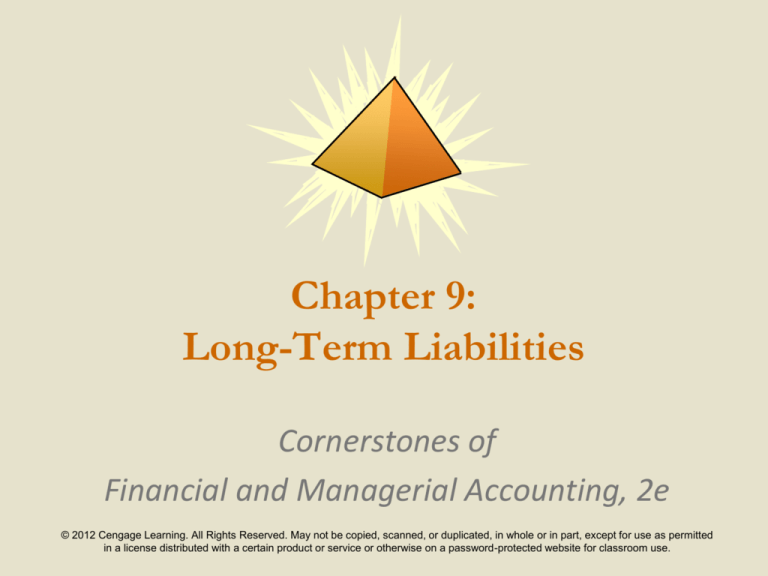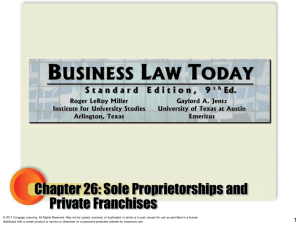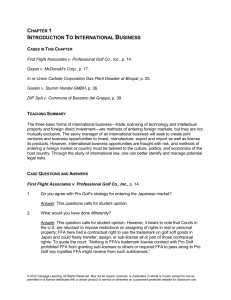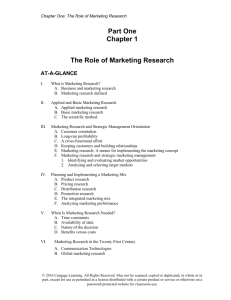
Chapter 9:
Long-Term Liabilities
Cornerstones of
Financial and Managerial Accounting, 2e
© 2012 Cengage Learning. All Rights Reserved. May not be copied, scanned, or duplicated, in whole or in part, except for use as permitted
in a license distributed with a certain product or service or otherwise on a password-protected website for classroom use.
Learning Objectives
1. Describe debt securities and the markets in which they are
issued.
2. Account for the issuance of long-term debt.
3. Use the straight-line method to account for premium/discount
amortization.
4. Use the effective interest rate method to account for
premium/discount amortization.
5. Determine the after-tax cost of financing with debt and explain
financial leverage.
6. Compare and contrast operating and capital leases.
7. Analyze a company’s long-term solvency using information
related to long-term liabilities.
8. (Appendix 9A) Calculate the market price of long-term debt
using present value techniques.
© 2012 Cengage Learning. All Rights Reserved. May not be copied, scanned, or duplicated, in whole or in part, except for use as permitted in a
license distributed with a certain product or service or otherwise on a password-protected website for classroom use.
1
Bonds Payable and Notes Payable
► Long-term debt generally refers to obligations that extend beyond
one year, based on a formal agreement or contract. Bonds, longterm notes, debentures, and capital leases belong in this category
of liabilities.
► When a company borrows money from a bank, it typically signs a
formal agreement or contract called a ‘‘note.’’ Notes are also
issued in exchange for a noncash asset such as equipment.
Collectively, we refer to these notes as notes payable.
► A bond is a type of note that requires the issuing entity to pay the
face value of the bond to the holder when it matures and usually to
pay interest periodically at a specified rate. A bond issue essentially
breaks down a large debt into smaller chunks (usually $1,000)
because the total amount borrowed is too large for a single lender.
© 2012 Cengage Learning. All Rights Reserved. May not be copied, scanned, or duplicated, in whole or in part, except for use as permitted in a
license distributed with a certain product or service or otherwise on a password-protected website for classroom use.
1
Bonds Payable and Notes Payable
(continued)
► All debt contracts require the borrower to repay the face value
(also called par value or principal). Typically the face value is repaid
at maturity, which is a specified date in the future.
► However, some contracts require the principal to be repaid in, for
example, monthly installments. These contracts typically require
equal payments to be made each period. A portion of each
payment is interest and a portion is principal.
► Most debt contracts also require that the borrower make regular
interest payments. The amount of each interest payment can be
calculated from the face amount, the interest rate, and the number
of payments per year, all stated in the debt contract.
► The interest rate identified in a debt contract goes by various
names, including stated rate, coupon rate, and contract rate.
© 2012 Cengage Learning. All Rights Reserved. May not be copied, scanned, or duplicated, in whole or in part, except for use as permitted in a
license distributed with a certain product or service or otherwise on a password-protected website for classroom use.
1
Long-Term Debt Terms
© 2012 Cengage Learning. All Rights Reserved. May not be copied, scanned, or duplicated, in whole or in part, except for use as permitted in a
license distributed with a certain product or service or otherwise on a password-protected website for classroom use.
1
Selling New Debt Securities
► Borrowing, through the use of notes or bonds, is attractive to
businesses as a source of money because the relative cost of
issuing debt (such as the interest payments) is often lower
than the cost of issuing equity (such as giving up ownership
shares).
► Underwriters examine the provisions of the instrument
(secured or unsecured, callable or not callable, convertible or
not convertible), the credit standing of the borrowing
business, and the current conditions in the credit markets and
the economy as a whole to determine the market rate of
interest (or yield) for the bond.
© 2012 Cengage Learning. All Rights Reserved. May not be copied, scanned, or duplicated, in whole or in part, except for use as permitted in a
license distributed with a certain product or service or otherwise on a password-protected website for classroom use.
1
Relationships between
Stated Interest Rate and Yield
© 2012 Cengage Learning. All Rights Reserved. May not be copied, scanned, or duplicated, in whole or in part, except for use as permitted in a
license distributed with a certain product or service or otherwise on a password-protected website for classroom use.
1
You Decide
Fixed versus Variable-Rate Debt
© 2012 Cengage Learning. All Rights Reserved. May not be copied, scanned, or duplicated, in whole or in part, except for use as permitted in a
license distributed with a certain product or service or otherwise on a password-protected website for classroom use.
2
Accounting for
Issuance of Long-Term Debt
► There are three basic cash flows for which the issuing corporation must
account:
► Issuance: the cash received when the bonds are issued (the issue or
selling price)
► Interest: the interest payments
► Repayment: the repayment of the principal (or face value)
► If a corporation issues bonds of $500,000 (face), with a stated rate of 6.5%
payable annually, and the principal is due in five years. Here are all three
cash flows:
© 2012 Cengage Learning. All Rights Reserved. May not be copied, scanned, or duplicated, in whole or in part, except for use as permitted in a
license distributed with a certain product or service or otherwise on a password-protected website for classroom use.
2
Recording
Issuance of Long-Term Debt
► The market price for debt is typically quoted as a percentage
of face value.
► If $100,000 face value bonds are issued at 103, their selling
price is 103 percent of face value, or $103,000. Any amount
paid above the face value is called a premium.
► If the bond is issued below face value, this difference is called
a discount. For example, if these $100,000 face value bonds
were issued at 96, there would be a $4,000 discount.
► Any premium or discount is recorded in a separate account
called Premium on Bonds Payable or Discount on Bonds
Payable.
© 2012 Cengage Learning. All Rights Reserved. May not be copied, scanned, or duplicated, in whole or in part, except for use as permitted in a
license distributed with a certain product or service or otherwise on a password-protected website for classroom use.
2
Cornerstone 9-1
Recording the Issuance of Bonds
© 2012 Cengage Learning. All Rights Reserved. May not be copied, scanned, or duplicated, in whole or in part, except for use as permitted in a
license distributed with a certain product or service or otherwise on a password-protected website for classroom use.
3
Recognizing Interest Expense
and Repayment of Principal
► When an obligation extends over several interest periods, the
amount of interest associated with each period must be
determined.
► Interest amortization is the process used to determine the
amount of interest to be recorded in each of the periods the
liability is outstanding.
► This allocation has two parts:
1. the actual interest payment made to the lender during
the period, and
2. amortizing any premium or discount on the bond.
© 2012 Cengage Learning. All Rights Reserved. May not be copied, scanned, or duplicated, in whole or in part, except for use as permitted in a
license distributed with a certain product or service or otherwise on a password-protected website for classroom use.
3
Interest Amortization Methods
► There are two methods for amortizing any premium or
discount:
1. The effective interest rate method is based on
compound interest calculations. Interest expense for the
period is always the yield (the effective interest rate)
times the carrying (or book) value of the bonds at the
beginning of the period.
2. The straight-line method, on the other hand, represents
a simple approximation of effective interest amortization.
Equal amounts of premium or discount are amortized to
interest expense each period.
© 2012 Cengage Learning. All Rights Reserved. May not be copied, scanned, or duplicated, in whole or in part, except for use as permitted in a
license distributed with a certain product or service or otherwise on a password-protected website for classroom use.
3
The Straight-Line Method
►Using the straight-line method we account for:
►Debt with regular interest payments sold at their face or
par value.
►Debt with regular interest payments sold for more (a
premium) or less (a discount) than the face or par value.
►When debt is sold at par there is no premium or
discount to amortize.
►In this case, the interest expense reported on the
income statement is equal to the interest payment(s)
made to the creditor during the period.
© 2012 Cengage Learning. All Rights Reserved. May not be copied, scanned, or duplicated, in whole or in part, except for use as permitted in a
license distributed with a certain product or service or otherwise on a password-protected website for classroom use.
3
Cornerstone 9-2
Recording Interest Expense
for Bonds Sold at Par
© 2012 Cengage Learning. All Rights Reserved. May not be copied, scanned, or duplicated, in whole or in part, except for use as permitted in a
license distributed with a certain product or service or otherwise on a password-protected website for classroom use.
3
Cornerstone 9-2
Recording Interest Expense
for Bonds Sold at Par (continued)
© 2012 Cengage Learning. All Rights Reserved. May not be copied, scanned, or duplicated, in whole or in part, except for use as permitted in a
license distributed with a certain product or service or otherwise on a password-protected website for classroom use.
3
Debt with Regular Interest Payments
Sold at a Premium or Discount
► The sale of a bond at a discount or premium affects the
borrower’s interest expense because the total interest expense
is the difference between the payments to the lenders and the
amount received by the borrowing business.
► Let us compare a $1,000,000, 10 percent, five-year bond
contract with semiannual interest payments that are sold at a
$10,000 discount (99 percent of par) with the same issue sold at
a $20,000 premium (102 percent of par).
© 2012 Cengage Learning. All Rights Reserved. May not be copied, scanned, or duplicated, in whole or in part, except for use as permitted in a
license distributed with a certain product or service or otherwise on a password-protected website for classroom use.
3
Cornerstone 9-3
Recording Interest Expense for Bonds Sold
at a Discount Using the Straight-Line Method
© 2012 Cengage Learning. All Rights Reserved. May not be copied, scanned, or duplicated, in whole or in part, except for use as permitted in a
license distributed with a certain product or service or otherwise on a password-protected website for classroom use.
3
Cornerstone 9-3
Recording Interest Expense for Bonds Sold
at a Discount Using the Straight-Line Method
(continued)
© 2012 Cengage Learning. All Rights Reserved. May not be copied, scanned, or duplicated, in whole or in part, except for use as permitted in a
license distributed with a certain product or service or otherwise on a password-protected website for classroom use.
Cornerstone 9-3
3 Recording Interest Expense for Bonds Sold at a
Discount Using the Straight-Line Method
(continued)
© 2012 Cengage Learning. All Rights Reserved. May not be copied, scanned, or duplicated, in whole or in part, except for use as permitted in a
license distributed with a certain product or service or otherwise on a password-protected website for classroom use.
Cornerstone 9-4
3
Recording Interest Expense for Bonds Sold
at a Premium Using the Straight-Line Method
© 2012 Cengage Learning. All Rights Reserved. May not be copied, scanned, or duplicated, in whole or in part, except for use as permitted in a
license distributed with a certain product or service or otherwise on a password-protected website for classroom use.
Cornerstone 9-4
3
Recording Interest Expense for Bonds Sold
at a Premium Using the Straight-Line Method
(continued)
© 2012 Cengage Learning. All Rights Reserved. May not be copied, scanned, or duplicated, in whole or in part, except for use as permitted in a
license distributed with a certain product or service or otherwise on a password-protected website for classroom use.
3
Cornerstone 9-4
Recording Interest Expense for Bonds Sold at a
Premium Using the Straight-Line Method
(continued)
© 2012 Cengage Learning. All Rights Reserved. May not be copied, scanned, or duplicated, in whole or in part, except for use as permitted in a
license distributed with a certain product or service or otherwise on a password-protected website for classroom use.
3
Accruing Interest
► Assume that on September 1, 2011, Fry Communications borrows
$120,000,000 on a three-year, 7 percent note. The note requires annual
interest payments and repayment of the principal plus the final year’s
interest at the end of the third year.
► Even though no payment is due on Dec. 31, interest must be accrued for
the period.
© 2012 Cengage Learning. All Rights Reserved. May not be copied, scanned, or duplicated, in whole or in part, except for use as permitted in a
license distributed with a certain product or service or otherwise on a password-protected website for classroom use.
3
You Decide
Financial Statement Effects of Refinancing
© 2012 Cengage Learning. All Rights Reserved. May not be copied, scanned, or duplicated, in whole or in part, except for use as permitted in a
license distributed with a certain product or service or otherwise on a password-protected website for classroom use.
4
The Effective Interest Rate Method:
Recognizing Interest Expense and
Repayment of Principal
► The straight-line and effective interest rate methods are
identical when a bond is issued at par because there are no
premiums or discounts to amortize.
► Even when premiums or discounts exist, the total interest
expense over the life of the bonds is identical.
► To use the effective interest method, you must distinguish
between interest payments, which are calculated as follows:
Face Value x Stated Rate x Time (in Years)
and effective interest expense which is calculated as:
Carrying Value x Yield Rate x Time (in Years)
© 2012 Cengage Learning. All Rights Reserved. May not be copied, scanned, or duplicated, in whole or in part, except for use as permitted in a
license distributed with a certain product or service or otherwise on a password-protected website for classroom use.
4
Cornerstone 9-5
Recording Interest Expense
for Bonds Sold at a Discount
Using the Effective Interest Rate Method
© 2012 Cengage Learning. All Rights Reserved. May not be copied, scanned, or duplicated, in whole or in part, except for use as permitted in a
license distributed with a certain product or service or otherwise on a password-protected website for classroom use.
Cornerstone 9-5
4
Recording Interest Expense
for Bonds Sold at a Discount
Using the Effective Interest Rate Method (continued)
© 2012 Cengage Learning. All Rights Reserved. May not be copied, scanned, or duplicated, in whole or in part, except for use as permitted in a
license distributed with a certain product or service or otherwise on a password-protected website for classroom use.
4
Cornerstone 9-6
Recording Interest Expense
for Bonds Sold at a Premium
Using the Effective Interest Rate Method
© 2012 Cengage Learning. All Rights Reserved. May not be copied, scanned, or duplicated, in whole or in part, except for use as permitted in a
license distributed with a certain product or service or otherwise on a password-protected website for classroom use.
Cornerstone 9-6
4
Recording Interest Expense
for Bonds Sold at a Premium
Using the Effective Interest Rate Method (continued)
© 2012 Cengage Learning. All Rights Reserved. May not be copied, scanned, or duplicated, in whole or in part, except for use as permitted in a
license distributed with a certain product or service or otherwise on a password-protected website for classroom use.
Long-Term Debt Carrying Value
4
Using Straight-Line and Effective Interest
Methods to Amortize Premium and Discount
© 2012 Cengage Learning. All Rights Reserved. May not be copied, scanned, or duplicated, in whole or in part, except for use as permitted in a
license distributed with a certain product or service or otherwise on a password-protected website for classroom use.
4
Installment Debt
► Instead of paying off the principal at maturity, some debt
requires a portion of the principal to be paid off each period
(usually monthly), along with some interest.
► Classic installment debt payments are home mortgages or car
payments.
► Installment debt payments are the same each period, but the
portion that is considered interest changes because the
outstanding principal balance is changing.
► Initial monthly payments have a relatively high portion
allocated to interest because the outstanding loan balance is
relatively high. On the other hand, the last few payments
have a relatively low portion allocated to interest because the
outstanding loan balance is relatively low.
© 2012 Cengage Learning. All Rights Reserved. May not be copied, scanned, or duplicated, in whole or in part, except for use as permitted in a
license distributed with a certain product or service or otherwise on a password-protected website for classroom use.
5
Pros and Cons of Debt Financing
► A business must weigh both the negative and positive aspects of debt
financing in deciding whether or not to take the risk.
► One advantage of financing with debt rather than stock is that the
interest expense on debt is deductible for income tax purposes.
► Another potential advantage of debt is that it fixes the amount of
compensation to the lender. Thus, if the borrowed capital generates
income in excess of the interest on the debt, the firm’s stockholders
benefit. The use of borrowed capital to produce more income than needed to
pay the interest on the debt is called leverage.
► A third advantage of financing with debt is that in periods of inflation,
debt permits the borrower to repay the lender in dollars that have
declined in purchasing power.
► The primary negative attribute of debt is the inflexibility of the
payment schedule, which could force borrowers into bankruptcy.
© 2012 Cengage Learning. All Rights Reserved. May not be copied, scanned, or duplicated, in whole or in part, except for use as permitted in a
license distributed with a certain product or service or otherwise on a password-protected website for classroom use.
6
Leases
► Many companies choose to lease, instead of purchase, some of their
assets.
► In an operating lease, the lessor (the legal owner of the asset) retains
substantially all of the risks and obligations of ownership, while the
lessee uses the asset during the term of the lease.
► A capital lease, on the other hand, is a noncancelable agreement that
is in substance a purchase of the leased asset.
► If a lease has any of the following characteristics, it is essentially a
purchase, and is therefore considered a capital lease:
► A transfer of the leased asset to the lessee occurs at the end of the lease
at no cost or at a ‘‘bargain price.’’
► The term for the lease is at least 75 percent of the economic life of the
leased asset.
► The present value of the lease payments is at least 90 percent of the fair
value of the leased asset.
© 2012 Cengage Learning. All Rights Reserved. May not be copied, scanned, or duplicated, in whole or in part, except for use as permitted in a
license distributed with a certain product or service or otherwise on a password-protected website for classroom use.
7
Ratio Analysis
► Although long-term creditors are concerned with a company’s
short-term liquidity, they are primarily concerned with its longterm solvency.
► As such, long-term creditors focus on ratios that are used to
analyze a company’s debt load and ability to cover interest
payment (coverage).
(1) Ratios to analyze debt load:
(2) Coverage ratios:
Times Interest Earned (Accrual Basis) =
Operating Income ÷ Interest Expense
Times Interest Earned (Cash Basis) =
(Operating Cash Flows + Interest and
Taxes Paid) ÷ Interest Payments
© 2012 Cengage Learning. All Rights Reserved. May not be copied, scanned, or duplicated, in whole or in part, except for use as permitted in a
license distributed with a certain product or service or otherwise on a password-protected website for classroom use.
7
Ethical Decisions
► When evaluating a company’s solvency, a major concern is
whether all debt was properly recorded.
► Companies have long engaged in transactions designed to hide
debt. Such transactions are typically called off-balance-sheet
financing.
► Interestingly, many such transactions are legal and considered
to be ethical by most.
► For example, many companies structure their lease agreements to avoid
meeting the criteria for capital leases that require recording an asset
and liability related to the future lease obligation. Because these leases
are then treated as operating leases, no asset or liability is recorded on
the books.
© 2012 Cengage Learning. All Rights Reserved. May not be copied, scanned, or duplicated, in whole or in part, except for use as permitted in a
license distributed with a certain product or service or otherwise on a password-protected website for classroom use.
7
Cornerstone 9-7
Calculating and Analyzing
Long-Term Debt Ratios
© 2012 Cengage Learning. All Rights Reserved. May not be copied, scanned, or duplicated, in whole or in part, except for use as permitted in a
license distributed with a certain product or service or otherwise on a password-protected website for classroom use.
7
Cornerstone 9-7
Calculating and Analyzing
Long-Term Debt Ratios (continued)
© 2012 Cengage Learning. All Rights Reserved. May not be copied, scanned, or duplicated, in whole or in part, except for use as permitted in a
license distributed with a certain product or service or otherwise on a password-protected website for classroom use.
8
Appendix 9A:
Pricing Long-Term Debt
► Debt agreements create contractually defined cash flows for
the lender.
► Specifically, lenders typically receive
► periodic interest payments and
► repayment of the loan principal at some future date (loan maturity).
► To receive these cash flows, the lender must decide how
much to lend.
► A lender decides how much to lend based on the present
value of future cash flows arising out of such lending. Two
kinds of cash flows arise—the periodic interest payments (an
annuity) and the repayment of the principal (a lump sum).
► For example, an investor values a bond at the present value of the two
future cash flows—the periodic interest payments and the repayment
of the principal.
© 2012 Cengage Learning. All Rights Reserved. May not be copied, scanned, or duplicated, in whole or in part, except for use as permitted in a
license distributed with a certain product or service or otherwise on a password-protected website for classroom use.
8
Cornerstone 9-8
Determining the Market Value of a Bond
© 2012 Cengage Learning. All Rights Reserved. May not be copied, scanned, or duplicated, in whole or in part, except for use as permitted in a
license distributed with a certain product or service or otherwise on a password-protected website for classroom use.
8
Cornerstone 9-8
Determining the Market Value of a Bond (continued)
© 2012 Cengage Learning. All Rights Reserved. May not be copied, scanned, or duplicated, in whole or in part, except for use as permitted in a
license distributed with a certain product or service or otherwise on a password-protected website for classroom use.








